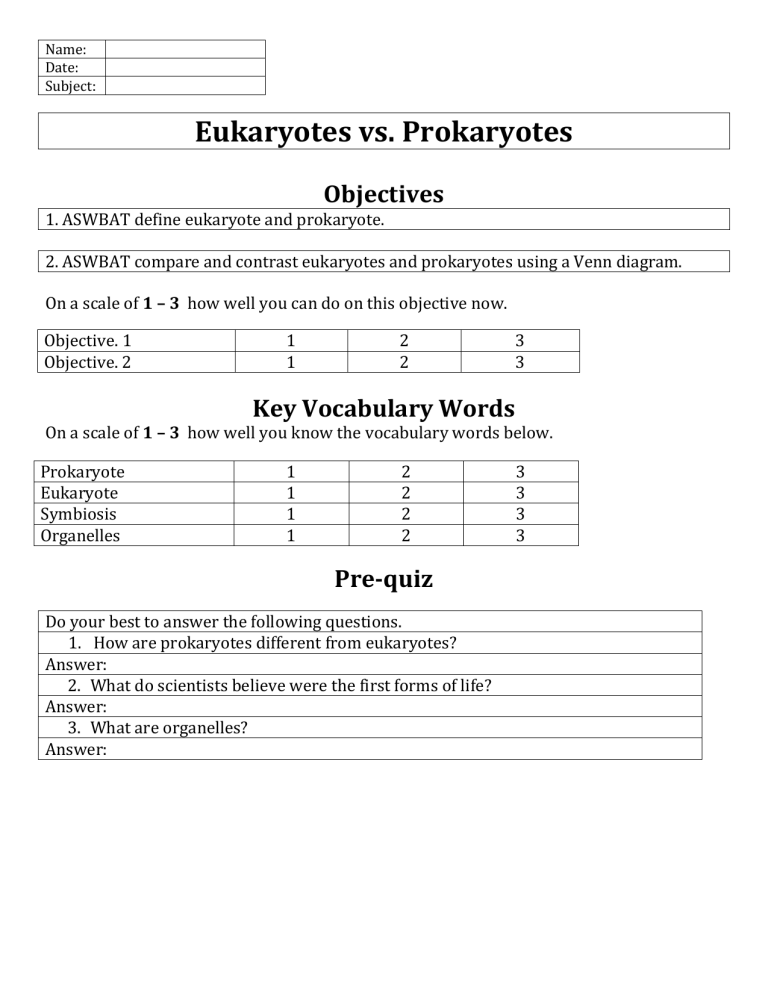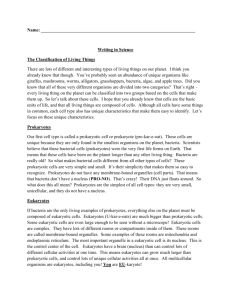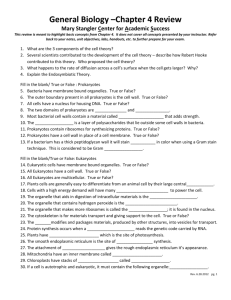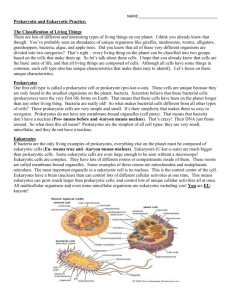Name: Date: Subject: Eukaryotes vs. Prokaryotes Objectives 1

Name:
Date:
Subject:
Eukaryotes vs. Prokaryotes
Objectives
1. ASWBAT define eukaryote and prokaryote.
2. ASWBAT compare and contrast eukaryotes and prokaryotes using a Venn diagram.
On a scale of 1 – 3 how well you can do on this objective now.
Objective. 1
Objective. 2
1
1
2
2
3
3
Key Vocabulary Words
On a scale of 1 – 3 how well you know the vocabulary words below.
Prokaryote
Eukaryote
Symbiosis
Organelles
1
1
1
1
2
2
2
2
3
3
3
3
Pre-quiz
Do your best to answer the following questions.
1. How are prokaryotes different from eukaryotes?
Answer:
2.
What do scientists believe were the first forms of life?
Answer:
3.
What are organelles?
Answer:
Prokaryotes
Bacteria are by far the most numerous organisms on Earth. In fact, on your body alone there are trillions of bacteria right now. You can’t see them because they are very small. In fact they are much smaller then most eukaryotic cells. All bacteria are classified as prokaryotes. Prokaryotes are cells that do not have membrane-covered organelles.
Because of this, they are relatively simple when compared to eukaryotes. Scientists theorize that they must have been the first forms of life to appear on Earth. They believe this because logic tells us that simple comes before complex. Like all cells prokaryotes have DNA. The DNA however instead of being linear, is circular. They also contain ribosomes. These ribosomes create proteins for the bacteria just like the ribosomes of a eukaryote. Prokaryotes also all have a cell wall. This wall protects the bacteria and provides them with structure just like the cell wall of plant cells. All bacteria are unicellular meaning they only exist as a single cell even though they sometimes live in colonies of trillions.
Video – Bacteria Growth
Video – Penicillin
Example of a prokaryotic cell (Bacteria)
1. What do prokaryotes not have that makes them different then eukaryotes?
`
Answer:
2. Why do scientists believe that the first forms of life were prokaryotes?
Answer:
Eukaryotes
Eukaryotes are much more complex then prokaryotes. Eukaryotic cells contain what are called membrane covered organelles and a nucleus. The nucleus contains the cells DNA and controls the cells functions. The DNA of a eukaryote is linear, unlike the DNA of a prokaryote that is circular. The organelles are like organs for cells. Just like our organs do for our bodies, organelles perform functions that help to keep the cells alive. Many eukaryotes are unicellular, but because eukaryotes are more complex they are able to team up with other cells and form multicellular organisms. In fact, all multicellular organisms are made of eukaryotic cells. So, they can be both unicellular and multicellular.
Both plant cells and animal cells are eukaryotes.
Eukaryotic Cells
Plant Cell Animal Cell
Nucleus
Membrane
Covered
Organelles
1. What do eukaryotic cells have that prokaryotic cells do not?
Answer:
2. Are eukaryotes unicellular or multicellular?
Answer:
3. What are the two main functions of the cell nucleus?
Answer:
Using the Venn diagram below, compare and contrast eukaryotes and prokaryotes.
Prokaryotes Both Eukaryotes
1.
2.
3.
1.
2.
3.
1.
2.
3.
Quiz
Directions: Answer the following questions to see if you met the objectives.
1.
What do eukaryotes have that prokaryotes do not?
Answer:
2.
What type of cells are all multicellular life forms made of? (Eukaryotes or
Prokaryotes)
Answer
3.
What are the functions of a nucleus?
Answer:
4.
Why do scientists believe that prokaryotes were the first forms of life?
Answer:
Using the Venn diagram below, compare and contrast eukaryotes and prokaryotes.
Prokaryotes Both Eukaryotes
1.
2.
3.
1.
2.
3.
1.
2.
3.








